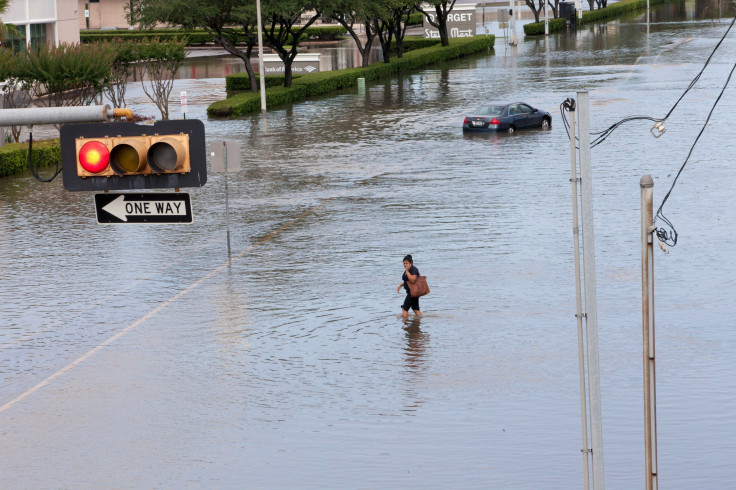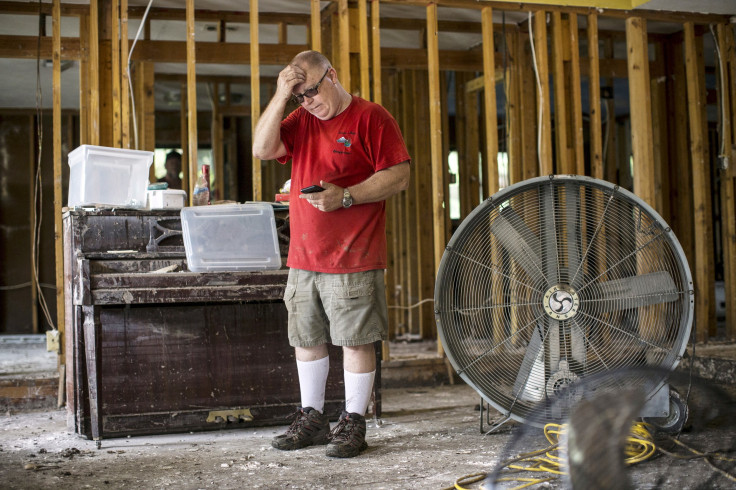After Texas Floods, A New Test for FEMA's Beleaguered National Flood Insurance Program

Less than 48 hours after torrential rains flooded parts of Houston in late May, AJ Culembourg found herself ripping up floor boards inside the rental property she and her husband remodeled 18 months ago. Flood waters had reached as high as 18 inches inside the one-story ranch home. Outside, it looked like it had been sitting in “its own private lake,” she says.
As Culembourg got to work, along came a small miracle. A Christian disaster relief group rolled up outside in a truck, and quickly deployed a crew to gut the house, and help Culembourg’s tenant cart her ruined belongings to the curb. On a somber occasion, “it was a godsend,” she says.
On Wednesday – exactly one week later – Culembourg waited for a different sort of help to arrive: her insurance adjuster. Her house was number 87 on the adjuster’s appointment list, with her slot scheduled for 4 p.m. She and her husband have a government-underwritten flood policy that covers the property for a maximum of $250,000.
Already, she’d heard neighbors say their homes might be total losses.
“Today is the first day we’ll get heads or tails on where we stand on it,” Culembourg says.
The Culembourgs and others like them will be counting on checks from their flood insurance policy to rebuild their homes and their lives. But if their case is anything like the thousands of Americans who’ve relied on FEMA’s National Flood Insurance Program in the recent past, the monetary relief may be hard to come by.
It is still early days for Texans and Oklahomans dealing with the aftermath of the floods. Yet for the homeowners who have coverage with FEMA, their claims will pose an important test for a program that has spent most of 2015 in crisis. The NFIP is now losing its reform-minded director as it continues to absorb stinging allegations that its partners -- private insurers -- altered damage assessments of properties and underpaid homeowners in New York and New Jersey in the aftermath of Hurricane Sandy.
The accusations have led to multiple criminal investigations by states' Attorneys General and a “war room” style task force, staffed by nearly 100 people within FEMA.
Just as the rains grew devastating in the west, Sandy victims were starting to sign up for an unprecedented review of their losses, open to any of the storm’s 144,000 claimants. Thus, at the same time that Texas and Oklahoma residents are making appointments with insurance adjusters, victims from a 2012 storm are submitting a fresh round of paperwork to get paid. Approximately 2,000 homeowners who sued, meanwhile, are still settling those cases with FEMA.
"There were lots of mistakes that were made after Sandy that hopefully won’t be made in Texas," says Amy Bach, executive director of insurance consumer advocacy group United Policyholders.
"But we have not by any stretch of the imagination solved the underlying problems” in the NFIP, she adds.

A spokesman for FEMA says NFIP is "putting survivors first" as it confronts the recent floods.
The NFIP is virtually the sole source of flood insurance for U.S. homeowners, and it relies heavily on insurance companies, known as Write-Your-Own carriers, or WYOs. The approximately 80 private insurers then subcontract with many other firms – including companies that handle administration and those that provide adjuster estimates and engineering reports.
“It’s a big privatization scheme,” Bach says, “and it has to be restructured.”
The Change-Agent
FEMA’s oversight of its vast network of contract players is “wholly inadequate,” Brad Kieserman, the NFIP’s outgoing reformer-in-chief, told Congress on Tuesday. Only about 75 federal employees oversee a small army of private contractors serving 5.3 million policyholders.
“We have lost the capability to detect and monitor problems in that program,” Kieserman testified to a House Financial Services subcommittee, ahead of his June 12 departure for a job with the American Red Cross.
In the case of Sandy victims, he said, that inability to detect problems early “devastated their lives.”
A lawyer who also served 22 years in the U.S. Coast Guard, Kieserman’s crisis-intervention resume includes the time he helped rescue the Maersk Alabama ship captain – later portrayed by Tom Hanks in the film “Captain Phillips” – when Somali pirates attacked the vessel in 2009.
FEMA administrator Craig Fugate chose Kieserman in February to lead turn-around efforts at the NFIP. He has spent the past four months putting out fires, negotiating settlements with homeowners, coordinating with non-profits on establishing the Sandy claims review and working with a U.S. Senate task force hammering out reforms.
During that time, he also went on “60 Minutes” and acknowledged that FEMA officials ignored early warning signs of potential fraud against Sandy victims.
But, as he told the subcommittee Tuesday, Kieserman still has not figured out what would incentivize any fraud to occur in the first place. “I do not understand why anyone would do any of the things that are alleged,” he said.
For that reason, Kieserman said, he has asked the Government Accountability Office to audit how funds flow in the deeply-indebted program, and he spoken “extensively” on the subject with New York Attorney General’s office, which is conducting its own investigation.
“I’m a big believer in follow the money,” he said.

Lawmakers Tuesday at turns praised Kieserman’s candor and lamented his departure -- echoing sentiments of attorneys and advocates who’ve worked with him.
Kieserman’s exit is a “net negative” says Steve Mostyn, a Texas-based lawyer whose firm has led settlement negotiations on behalf of Sandy homeowners for months. While Kieserman said he’s leaving government to help pay for his sons’ college education, Mostyn surmises that he’d also grown frustrated with what could be haltingly slow progress of an entrenched bureaucracy.
“When I needed to get things done, I went to Brad,” says Mostyn, who just last week requested additional time for recent flood victims to gather paperwork and file their claims (Kieserman granted it). “Now, he’s not there.”
History Repeats
But Sandy victims are hardly the first to complain that insurers who contract with the NFIP – a relationship that federal regulations refer to as “the Arrangement” – have underpaid claims.
After Hurricane Katrina, for example, a number of Gulf Coast residents alleged that insurers short-changed them on costly wind damage by attributing their losses to flooding, leaving the federally-backed program insurance program to pick up the tab.
In April, those allegations came roaring back to life in Mississippi. There, Attorney General Jim Hood has filed suit against former NFIP participant State Farm. The suit accuses State Farm of mischaracterizing wind damage as flood damage and costing the state “hundreds of millions of dollars” that it has paid to Katrina victims through a recovery program.
State Farm said the suit was “was not expected considering what we have done in solving claims as a result of Hurricane Katrina.”
The year before Sandy struck the East Coast, North Carolina state officials requested that FEMA review flood insurance claims stemming from Hurricane Irene, out of concern that insurance adjusters “have not done a sufficient job of examining homeowners or businesses property or worse have failed to follow up or show up to evaluate the claims.”
FEMA quickly acquiesced. Afterwards, though, the state insurance commissioner said flood insurance program’s actions warranted further scrutiny. “Given the overall complaints and complications North Carolina suffered as a result of the NFIP and FEMA, I am also encouraging our Congress to examine the response to Irene,” Commissioner Wayne Goodwin wrote in a 2012 memorandum.
U.S. Senators from New Jersey and New York began raising questions about underpayments to Sandy victims last summer. But it took a scathing decision from a New York federal judge -- two years after the storm -- to start sounding alarm bells on “reprehensible gamesmanship” toward homeowners.
“It shouldn’t take two years to recognize that,” Kieserman said Tuesday.
Even as larger reforms are ongoing, Kieserman attempted to reassure lawmakers that FEMA is being “hyper-attentive” to flood claims in Texas and Oklahoma. Earlier this week, FEMA issued a two-page memo to insurance companies, reminding them to “ensure that what can be paid is paid.”
Kieserman also said that the NFIP will set up a hotline for flood victims, and send in “secret shoppers” to keep tabs.
There’s a lot on the line.
“It’s just heartbreaking that two-and-a-half years out, some people are still not home after Sandy,” says Melissa Luckman, an attorney with the Disaster Relief Clinic at Touro Law Center in New York. “I would hate to see that happen again to anyone.”
© Copyright IBTimes 2024. All rights reserved.




















